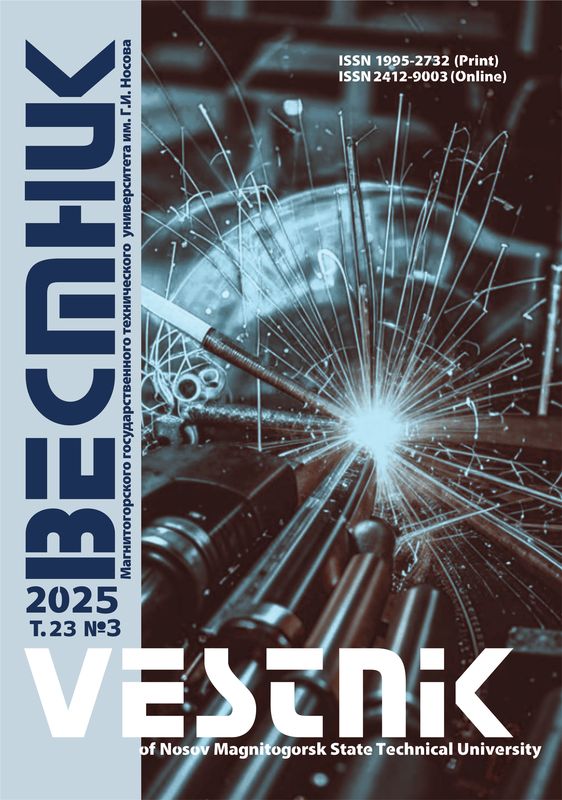Abstract
Problem Statement (Relevance): This article describes a method for determining the depth of a meniscus that may occur in liquid steel caused by the electrodynamic forces present in an AC electric arc furnace (EAF). Such information can be helpful when assessing the degree of arc shielding or optimizing the furnace operation. Until recently, it used to take costly experiments to identify the parameters which characterize the effect produced by the arc on steel as there were no means to monitor them. Objectives: This paper aims to develop an approach to identify such parameters based on a large amount of process data accumulated under normal operating conditions. Methods Applied: The method is based on the correlation between the electrode movement and the changing electrical parameters of the furnace. A number of different arc models have been considered and a number of assumptions made as to the shape of meniscus, which can help estimate the effect of electrodynamic forces. The process data that was used for model calibration included 300 heats. Originality: This paper demonstrates the actual possibility of using simple models simulating the interaction between the AC arc and the liquid steel to identify the meniscus depth based on actual process data. The article also provides all the necessary mathware and algorithms. Findings: Based on the assumptions made, a mathematical expression was established that represented the relationship between the average depth of the meniscus and the effect produced by the arc on steel. Relasionships were established for the meniscus depth as a function of the electrical parameters in the instance of EAF-180 functioning at the site of Magnitogorsk Iron and Steel Works OJSC. Practical Relevance: Using the information about the meniscus depth, one can estimate what degree of arc shielding is required for different operating modes while tackling the power optimization tasks. Another important application is the opportunity to study disturbances as correlated with the level of steel in the furnace, which can serve as an indirect indication of the turbulence patterns.
Keywords
Electric arc model, submersion, axial electrodynamic forces, meniscus depth, arc column.
1. Jones, J.A.T. Smart-Gas – A New Approach of Optimizing EAF Operation. J.A.T. Jones, S. Matson, P. Safe. AISTech Proceedings. 2006, no. 1, pp. 473–481.
2. Ryabchikov M.Yu., Parsunkin B.N., Ryabchikova E.S. Choosing operating modes of a ladle-furnace based on general quality assessment and process costs. Chernyie metallyi [Ferrous metals]. 2014, no. 12 (996), pp. 28–34. (In Russ.)
3. Billings, S. Modelling a three-phase electric arc furnace: a comparative study of control strategies. Applied Mathematical Modeling. APPL MATH MODEL. 1997, vol. 1, no. 7, pp. 355–361.
4. Afanasiev V.V., Vishnevskiy Yu.I. Vozdushnyie vyiklyuchateli [Air circuit breakers]. Leningrad: Energoatomizdat, 1981. 384 p. (In Russ.)
5. Makarov A.N., Sokolov A.Yu. Electrical, geometrical and thermal parameters of arcs burning in metal vapour. Elektrometallurgiya [Electrometallurgy]. 2009, no. 11, pp. 19–24. (In Russ.)
6. Makarov A.N., Sokolov A.Yu., Lugovoy Yu.A. Discussing the problem: The reaction of the authors A.N. Makarov, A.Yu. Sokolov, Yu.A. Lugovoy on the review prepared by N.V. Evseeva on the following article: Improving the performance of arcs by removing the electromagnetic impact in electric arc furnaces. Elektrometallurgiya [Electrometallurgy]. 2012, no. 4, pp. 27–31. (In Russ.)
7. Sokolov A.Yu. Razrabotka dugovoy staleplavilnoy pechi s pitaniem ot treh odnofaznyih transformatorov [Designing an electric arc furnace energized by three single-phase transformers]. Ph.D. dissertation. Tver, 2010. 138 p. (In Russ.)
8. Svenchanskiy A.D., Zherdev I.T., Kruchinin A.M. et al. Elektricheskie promyishlennyie pechi: Dugovyie pechi i ustanovki spetsialnogo nagreva [Industrial electric furnaces: Electric arc furnaces and special heating units]. Ed. by A.D. Svenchanskiy. Moscow: Energoizdat, 1981. 296 p. (In Russ.)
9. Sinkevich O.A., Stakhanov I.P. Fizika plazmy [The physics of plasma]. Moscow: Vyisshaya Shkola, 1991. 191 p. (In Russ.)
10. Fortov V.E. The interaction of low-temperature plasma with condensed material, gas and electromagnetic field. Numeric modelling of low-temperature plasma. The chemistry of low-temperature plasma. Entsiklopediya nizkotemperaturnoy plazmyi: Vvodny tom: v 4 tomakh. T. 3. [Encyclopedia of low temperature plasma: Introduction: 4 Volumes. Vol. 3]. Moscow: Nauka/Interperiodika, 2000. 574 p. (In Russ.)
11. Egorov A.V., Morzhin A.F. Dugovyie staleplavilnyie pechi postoyannogo toka [DC arc furnaces]. Moscow: Chermetinformatsiya, 1992. 23 p. (In Russ.)
12. Evseeva N.V., Lazuko L.A., Cherkasova Yu.B., Khasanov S.U. A study of electrodynamic forces acting on the arcs in a three-phase electric arc furnace. Vestnik Yuzhno-Uralskogo gosudarstvennogo universiteta [Bulletin of the South Ural State University]. 2011, no. 34 (251), pp. 69–74. (In Russ.)
13. Makarov A.N. Teoriya i praktika teploobmena v elektrodugovyih i fakelnyih pechah, topkah, kamerah sgoraniya [The theory and practice of heat exchange in electric arc and torch furnaces, fire chambers, and combustion chambers]. Tver: TGTU, 2007. 184 p. (In Russ.)
14. Spelitsin R.I. A study of the arc submersion in the metal bath of a superpower electric arc furnace. Elektrotehnicheskaya promyishlennost. Ser. Elektrotermiya [Electrical industry. The electrothermics series].1975, no. 12, pp. 10–11. (In Russ.)
15. Pirozhnikov V.E. Avtomatizatsiya elektrostaleplavilnogo proizvodstva [Automation of electric arc furnace process]. Moscow: Metallurgiya, 1985. 184 p. (In Russ.)
16. Ryabchikova E.S., Ryabchikov M.Yu., Parsunkin B.N. Mathware for the ladle furnace process control model. Avtomatizirovannye tekhnologii i proizvodstva [Automation of technologies and production]. 2013, no. 5, pp. 54–66. (In Russ.)
17. Ryabchikova E.S., Ryabchikov M.Yu., Parsunkin B.N. Simulation of low-frequency perturbations in the AC arc furnace type 180. Elektrometallurgiya [Electrometallurgy]. 2015, no. 5, pp.31–40. (In Russ.)
18. Zheng, Tongxin. An adaptive arc furnace model. Tongxin Zheng, Elham B. Makram. IEEE Transactions on Power Delivery – IEEE TRANS POWER DELIVERY. 2000, vol. 15, no. 3. pp. 931–939. (In Russ.)












